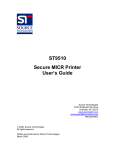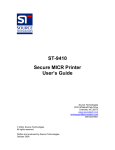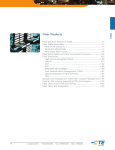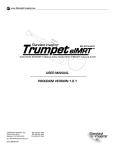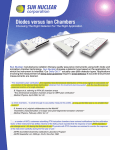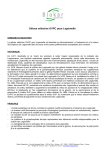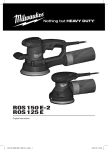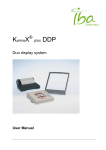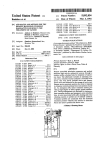Download HDR 1000 Well Chamber
Transcript
SeeDOS Product User Manual HDR 1000 Plus Ionization Chamber Table of Contents General Precautions ...................................................... 2 Features and Specifications .......................................... 3 General Procedures for Medical Measurements ........... 4 Overview ...................................................................... 6 Operation ...................................................................... 8 192 Procedures for Calibration of HDR Ir sources ........ 10 Procedures for Calibration and Measurement of LDR Brachytherapy Sources ............................... 13 Procedures for Specific Source Holders ..................... 14 Calibration of HDR 1000 Plus ................................... 25 Constancy Check of HDR 1000 Plus ......................... 25 Maintenance................................................................ 26 Service ........................................................................ 26 Brachytherapy Parts List ............................................ 27 Bibliography; HDR Iridium Measurements ............... 28 Customer Responsibility ............................................ 29 Warranty ..................................................................... 30 General Precautions WARNING: Electrical shock hazard when connected to 300 V bias supply. Do not remove cover. CAUTION: Proper use of this device depends on careful reading of all instructions and labels. CAUTION: This device should never be submerged to clean or scrubbed with an abrasive cleaner. CAUTION: Do not drop, mishandle, or disassemble unit since it may result in change of calibration factor. Refer all servicing to qualified individuals. CAUTION: Do not sharply bend triax cable. Damage to the cable may result in high leakage currents. CAUTION: Insure source freely moves within secured catheter. Proper location of source is necessary to assure proper calibration. –2– Features and Specifications ADCL Calibrations Active Volume Isotope Source Holder Connector Range Cable Bias Voltage Applied Leakage Stability Response Sensitivity Aion Case Dimensions Height Diameter Insert Diameter Insert Height Weight HDR 192Ir and/or LDR radionuclides as requested 245 cm3 11 source holders available Two lug triax (standard), TNC, or BNC + Banana (optional) 0.01 mCi to 20 Ci 1 meter (3 feet) ±300 volts, typical Less than 50 fA 0.2% (Reproducibility over 2 years) ± 0.5% over 25mm at center of axis Approximately 8.7 nA/Ci, typical for HDR Ir 0.9996 Wooden carrying case 15.6 cm (6.1 in.) 10.2 cm (4 in.) 3.5 cm (1.4 in.) 12.1 cm (4.8 in.) 2.7 kg (6.1 lbs) Specifications are subject to change without notice. –3– General Procedures for Medical Measurements The following procedures should be used any time that measurements are to be made with an ionization chamber and electrometer system. This applies only to the setup of the ionization chamber and electrometer, not to the setup of the ionization source. 1. With nothing connected to the input jack of the electrometer, turn the power on and wait at least 10 minutes for warm up. 2. Verify the leakage of the electrometer is within the manufacturer’s stated acceptable limits. 3. Connect the ionization chamber to the electrometer and apply 100% voltage bias. 4. Allow the electrometer and the ionization chamber system at least 10 minutes to stabilize,making certain that all cabling is lying flat and unkinked. 5. Verify the leakage of the ionization chamber is within the manufacturer’s stated acceptable limits. 6. Some electrometers, such as the Standard Imaging MAX 4000 Electrometer, allow the user to zero the device at any time. If desired, perform this system zeroing now. 7. Check the system leakage. Take a reading without exposing the chamber to radiation. This reading should be less than 0.1% of the final signal expected. 8. Measure the atmospheric temperature and pressure. –4– 9. Turn on or insert the radiation source(s) and take at least 3 measurements. Generally the measurments should not be moving in only one direction (i.e. three readings that continue to drop and hence may not yet be stabilized). 10. Analyze the data taking into account the average of the readings, system leakage, temperature/pressure corrections, calibration factors and any other appropriate corrections to be made. Keep in mind that the calibration factor consists of the electrometer calibration factor and the ionization chamber calibration factor. 11. When all measurements are completed, set bias voltage to 0VDC, turn off the electrometer and disconnect the ionization chamber. –5– Overview The Standard Imaging HDR 1000 Plus Ionization chamber is a well-type chamber. It is specifically designed for use with both the brachytherapy high-dose-rate (HDR) remote afterloading irradiators and low-dose-rate (LDR) brachytherapy sources, with the appropriate calibration. It is recommended that the chamber be calibrated every two years as is standard practice for other ionization chambers. Initially, the calibration factor is given in the calibration report from the Accredited Dosimetry Calibration Laboratory (ADCL). The appendix provided with the calibration report discusses the calibration factors in greater detail. Calibration factors should be obtained from an ADCL for each brachytherapy source that is being measured. The ionization current expected from the HDR 1000 Plus is approximately 8.7 nA/Ci for HDR brachytherapy sources. Thus, the measurement of all brachytherapy sources requires an electrometer with a calibrated scale for measuring currents in the range from 10-8A to 10-7A. Alternatively, a calibrated charge scale may be used with timed runs. If integral charge techniques are used with the time determined by the HDR irradiator timer, the contribution from the source transit-time should be taken into account. The HDR afterloading technique minimizes potential radiation exposure to medical personnel and permits brachytherapy treatments in a shorter time period. Calibration of all brachytherapy sources with ionization chambers is important. When a brachytherapy source with a high dose rate is used, it is imperative that there be an accurate and reliable calibration of the source strength by means of a suitable chamber, such as the HDR 1000 Plus. The initial activity of the 192Ir sources for high dose rate –6– brachytherapy applications is typically around 10 curies (Ci), or 370 gigabecquerels (GBq). The half life of 192 Ir is 73.83 days. Therefore, frequent (usually quarterly) source replacements are required. These sources must be calibrated when placed in use and should be checked periodically during use. Suppliers of sources usually provide calibration certificates that can have an uncertainty of ±10%, necessitating an independent calibration for better accuracy. This point is addressed in the article published in Int. J. Radiat. Oncol. Biol. Phys. 24: 167-170 (1992) and Chapter 5 of High Dose Rate Brachytherapy: A Textbook, ed. S. Nag. Calibration methods for HDR sources using methods other than the HDR 1000 Plus welltype chamber can be complicated, time-consuming and prone to error. The HDR 1000 Plus is convenient for frequent use, since the time required for calibration is only a fraction of that required for thimble ionization chamber techniques. A recommended calibration technique is given in Med. Phys. 18: 462-467 (1991). Please note that the factors that are used in the calibration of these chambers are the most current, and in some cases, may be different than those used in HDR treatment planning computers. This difference, if present, should be accounted for during your treatment planning activities. To avoid confusion, the American Association of Physicists in Medicine has recommended that air kerma calibrations be used for brachytherapy sources (AAPM Reports No. 41 and 21) instead of source activity. –7– Operation The HDR 1000 Plus ionization chamber has a vent hole to maintain the internal air at ambient atmospheric pressure. Thus, the readings obtained must be corrected for ambient temperature and pressure to the temperature and pressure of calibration (22o C and 760 mm Hg) at “normal” relative humidity (50% ± 25%non-condensing) in the usual accepted manner. The HDR 1000 Plus has available different inserts for HDR measurements, including a quality assurance (QA) insert. Note that the QA insert can provide information for source positioning verification, timer accuracy and consistency of source activity for HDR applications. This tool is described in Med. Phys. 22: April 1995 and in a separate instruction manual. Contact Standard Imaging for further information. The inserts are designed so that the center of all sources are located at the most sensitive spot of the chamber. Figure 1 shows a typical axial response curve for the HDR 1000 Plus. There is only a 0.1% decrease in sensitivity within + 5 mm of center. The HDR 1000 Plus utilizes a conventional triax connector and cable to be connected to a suitable electrometer. A bias of 300 volts must be applied to the electrometer low-impedance connection relative to chassis ground. The voltage polarity effect is less than 0.1%. If desired, a second bias level of 150 volts can also be used to determine the ionic recombination loss at 300 V. 1 The ionic recombination loss is less than 0.05% and thus can be considered negligible. The chamber calibration refers to the positive and negative voltage average. 1 The equation used is A ion = 4/3 - (Q1/3Q2), where Q1 is the charge or current measured at 300 V and Q2 is the charge or current measured at 150 V. See Med. Phys. 11: 714 (1984). –8– 101 100 99 Percent Response 98 97 96 20 30 40 50 60 70 80 Distance from Bottom of Chamber (mm) Figure 1: Typical axial response shown as a percent with distance from the bottom of the chamber. The step by step procedure for measurement of HDR sources is given. The chamber should not be placed near a high scatter environment during measurements for the best accuracy; it should be located at least 25 cm from a wall or other high-scattering environment as described in Med. Phys. 19: 1311, 1992. –9– Procedures for calibration of HDR 192Ir sources 1. Place the HDR 1000 Plus chamber in the same room as the HDR unit for at least 30 minutes before the measurement to allow it to equilibrate to ambient temperature and pressure. 2. Connect the HDR 1000 Plus chamber to a suitable electrometer, such as the MAX 4000 from Standard Imaging, and apply 300 V bias voltage. Allow the system to stabilize for at least 10 min. 3. Connect a catheter, such as the endobronchial, French 6 blue catheter to HDR irradiator. 4. Align the black dot on the well insert with the punch mark on the body of the chamber (See Figure 2). 5. Insert catheter end to bottom of chamber source holding insert. The dead space at the catheter end 192 must be known, so that the center of the Ir source can be positioned at the most sensitive position of the chamber. See Figure 1 for a typical axial response curve for the HDR 1000 Plus. Normally the most sensitive spot for the HDR 1000 Plus chamber is between 50 and 53 mm from the bottom of the source tube. This point is provided in the calibration report for each chamber. The chamber sensitivity decreases by approximately 0.1% when the source is moved up or down by 5 mm from that position. 6. Secure the catheter with the knurled catheter holding device. – 10 – Black dot Punch mark Figure 2 7. After performing all manufacturer recommended safety procedures for the HDR after-loading device, 192 run the Ir source to the radiation sensitive axial point of the chamber for a minimum of 20 sec for current measurement or for a reproducible set time (1 min.) for charge measurement. If the charge mode is used and the charge is accumulated while the source is in transit, account for the transit time error of the source by making the standard timer end effect measurements as described in High Dose Rate Brachytherapy: A Textbook, Nag, ed. Futura, 1994. Note: This value will differ depending on the length of the catheter. The timer feature of the Standard Imaging MAX 4000 (REF 90015) can be used to collect charge for set times and eliminate this effect. – 11 – 8. Read and record the measured current or charge. 9. Use correction factors for temperature/pressure, electrometer correction factor (electrometer must be calibrated) and calibration factor for the HDR 1000 Plus given by the Accredited Dosimetry Calibration Laboratory to calculate the activity of the source. The following equation can be used (for example if the activity is desired, the calibration factor for the activity from the calibration report would be used for C) B=R*F*E*C where: B = the Activity of the source in Bq or Ci depending which calibration factor is used. R = the reading in A (if current scale) or in C/s (if charge scale measured for a set time in s) F = the temperature and pressure correction factor E = the correction factor for the electrometer scale C = the HDR 1000 Plus calibration factor (in this case the activity calibration factor) Note: “B” can be divided by Aion if desired to correct for recombination effects. Since the HDR 1000 Plus has an Aion of 1.000, this is not necessary. For example, if R = 5.435 x 10-8 A, F = 1.021, E = 0.999 and C = 1.271 x 108 Ci/A, then B = (5.435 x 10-8) * (1.021) * (0.999) * (1.271 x 108) = 7.05 Ci – 12 – Procedures for Calibration and Measurement of LDR Brachytherapy Sources 1. Place the HDR 1000 Plus Brachytherapy Well Chamber in the same room the measurements are to be done in for at least 30 minutes to equilibrate to ambient temperature and pressure 2. Connect the HDR 1000 Plus chamber to a suitable electrometer and supply 300 V bias voltage. Allow system to stabilize for at least 10 minutes. 3. Insert the appropriate source holder for the brachytherapy source to be measured into the chamber. Align the black dot on the well insert with the punch mark on the body of the chamber (see Figure 2 in HDR iridium procedure). 4. Using appropriate safety procedures for brachytherapy sources, insert the source into the source tube. 5. Measure the LDR brachytherapy source for a minimum of 20 seconds for current measurements, or for a reproducible set time for charge measurements. 6. Read and record the measured current or charge. 7. Use correction factor for temperature/pressure, electrometer correction factor (electrometer must be calibrated) and isotope calibration factor to calculate the activity of the source. The following equation can be used B=R*F*E*C Refer to step 9 on the previous page. – 13 – Procedures for Specific Source Holders 1. 70020 Source Holder for Cesium Manual Afterloading, 5mm opening. 137 For Cs calibrations, verify the plastic spacer inside the source holder insert is at the bottom of the source holder. Place the cesium source in the source holder for the measurement. REF 70020 2. REF 70003 70003 Source Holder for Cesium Remote Afterloading Systems, 7.1mm opening. Insert the remote afterloading catheter into the source holder. Advance the cesium source to the bottom of the source holder. Retract the source to the most sensitive area of the well chamber. Take a measurement. 3. 70009 Source Holder for Low Dose Rate Iridium Ribbons Insert the ribbon into the source holder so all seeds are in the helical portion of the source holder and not in the tube feeding the helix. Take a measurement – 14 – 192 A correction factor for Ir seeds in ribbons can be determined. Select a ribbon that can be sacrificed. Measure the signal for all seeds together. On the same day, cut the ribbon into individual seed sections and measure each seed individually. Compare the sum of the activity of the individual seeds to the activity of the entire ribbon. Calculate a correction factor for the ribbons. This correction factor is the result of shadowing of the seeds by other seeds. REF 70016 REF 70009 4. 70016 Source Holder for Single LDR Seeds, 1.2mm opening. Insert an individual seed into the Teflon tube of the source holder. The source holder will place the seed at the most active area of the chamber. Take a measurement. A seed can be removed by taking the source holder out of the HDR 1000 Plus chamber and inverting. The Teflon tube will allow the seed to easily slide out. ADCL calibrations are available for LDR iridium, iodine and palladium seeds. ADCL calibrations are not available for gold. – 15 – 5. 70022 Source Holder for LDR Seed Batch Assay The Source Holder for LDR Seed Batch Assay, REF 70022, is designed to hold up to 500 of the low dose rate iodine or palladium seeds. The seeds to be measured are positioned at the most sensitive position on axis of the HDR 1000 Plus Brachytherapy Ion Chamber. The purpose of this source holder is to enable physicists to sample a subset, typically 10%, of the large numbers of seeds often received for treatment of cancer. For example, if several treatments for prostate cancer are imminent, 50 to 200 seeds may be used per case. REF 70022 To measure a number of seeds, place the desired number in the Source Holder for LDR Seed Batch Assay. Place the source holder in the HDR 1000 Plus Ion Chamber. The seeds are centered at the most sensitive part of the chamber. A reading can be made with any standard electrometer. For consistency of measurements, and to save time, the Standard Imaging MAX 4000 Electrometer can be set to collect – 16 – charge for a user defined amount of time. An explanation of how to perform sample measurements is explained very well in the reference “Verifi125 103 cation of manufacturer-supplied I and Pd airkerma strengths.” Mellenberg and Kline; Medical Physics. 22(9):1495-1497, 1995. A thorough review of this article is recommended. Correction factors for varying numbers of seeds need to be determined for either iodine or palladium, depending on which isotope is used. This is due to the self absorption of the seeds in the source holder. Once determined these factors should remain constant. Thereafter a set number of seeds, i.e. 25, 50, 100, can be measured. References 125 103 1. “Verification of manufacturer-supplied I and Pd airkerma strengths”. Mellenberg & Kline; Medical Physics. 22(9):1495-1497, 1995. 2. “Comprehensive QA for radiation oncology: Report of AAPM Radiation Therapy Committee Task Group 40”. Medical Physics. 21(4):581-618, 1994. – 17 – 6. 70023 Source Holder for RAPID Strand Seeds TM Iodine The source holder for RAPID Strand Iodine Seeds is designed for QA measurements of the RAPID Strand 6711 Iodine Seeds prior to use. This insert works with the Standard Imaging HDR 1000 Plus Brachytherapy Well Chamber. The RAPID Strand Source Holder is constructed to simultaneously measure five seeds at one end of the RAPID Strand while the RAPID Strand remains in the spacing jig. The spacing jig is then inverted in the source holder and the five seeds at the other end are measured. This provides a QA check of the relative activity of the five seeds on each end of the RAPID Strand. RAPID Strand™ REF 70023 A RAPID Strand containing 10 iodine seeds was obtained and an extensive evaluation was performed with the HDR 1000 Plus and the RAPID Strand Source Holder 70023. Following the evaluation, individual seeds of the RAPID Strand were cut from the strand and individually calibrated. These measurements were compared to the initial, collective – 18 – seed measurements of the intact RAPID Strand in Source Holder 70023 to obtain a correction factor. The correction factor was found to be approximately 1.15 times the 6711 iodine calibration factor from the University of Wisconsin Accredited Dosimetry Calibration Laboratory. The RAPID Strand Source Holder, REF 70023, can be gas sterilized or steam sterilized (autoclaved). To measure a RAPID Strand of iodine seeds, place the spacing jig, with the RAPID Strand in place, into the source holder. There is a plastic key on the bottom of the lead shielding to guide the spacing jig so the seeds are in the center of the well chamber. There is no measurable rotational dependence. Record the measured activity. Invert the RAPID Strand and take another measurement. A formula can be used to determine the average seed activity as a QA measurement of the sum of the activity of 5 seeds. Seed Activity = R * CF * CT/P * EF N Seed Activity = average seed activity as a QA measurement R = reading CF(correction factor) = defined as approximately 1.15 times the ADCL 6711 iodine calibration factor N = number of seeds CT/P = correction for temperature and pressure EF = electrometer correction factor – 19 – For Example: If you receive a strand with a nominal or average 2 -1 activity of 0.3µGym h per seed, the typical 5 seeds were measured, and the iodine calibration factor of 11 2 -1 -1 2.6 x 10 µGym h A is used. Assume: -11 R = 0.4957 x 10 A 11 CF = (1.15) (2.6 x 10 ) N = 5 C = 1.014 T/P EF = 0.998 Seed Activity = -11 11 (0.4957 x 10 A)(2.6 x 10 ) (1.15) (1.014) (0.998) 5 2 -1 Seed Activity = 0.3µGym h This average seed activity, as a QA measurement, can be compared to your expected RAPID Strand activity. Note, this is a QA measurement assuming the five seeds are the same activity. – 20 – 7. 70024 Source Holder for MICK® Cartridge This source holder allows for a constancy QA check of the seeds. After the MICK cartridge is loaded, insert the cartridge into the holder so that the black part is on top. Screw the cartidge into the holder and make sure the seeds are not blocked by the metal posts. See figure below. – 21 – 8. 70026 Source Holder for 5cc and 10cc Syringes This source holder has been designed to provide a quick and convenient QA measurement of liquid sources in syringes. Simply place the appropriate source holder in the HDR 1000 Plus chamber for a measurement. Source Holder 70026 for 5cc and 10cc Syringes, includes one set of two syringe holders, one for a 5cc syringe and one for a 10cc syringe. Example: For a Medastron source, a 4mCi dose in a 5cc syringe gives an approximate 3.3+0.1nC signal in 60 seconds. A 4mCi dose in a 10cc syringe gives an approximate 3.03 +0.05nC signal in 60 seconds. SOURCE HOLDER 70026 WELL CHAMBER WELL CHAMBER REF 70026 – 22 – 9. Using the Bard EXPRESS SEEDING CARTRIDGE Source Holder, REF 70032 Step 2: Thread the Seeding Cartridge onto the Handler as shown above. Note the radiation shield is still over the Seeding Cartridge. Step 1: Adjust the Indexer to display the number of seeds to be tested in the Seeding Cartridge. The Indexer shown above is set for 4 seeds. Step 3: Remove the radiation shield and insert the Seeding Cartridge through the Indexer and into the HDR 1000 Plus Well Chamber. Step 4: Assembly ready for measurement with the HDR 1000 Plus Well Chamber. The Bard EXPRESS SEEDING CARTRIDGE Source Holder is designed for QA measurements of palladium or iodine seeds prior to use. When used with the Standard Imaging HDR 1000 Plus Well Chamber, this Holder provides a check of the relative activity of the seeds held within an Bard EXPRESS SEEDING CARTRIDGE. In addition, the Holder can be gas sterilized or steam sterilized (autoclaved). Evaluations were performed at the University – 23 – of Wisconsin ADCL and K&S Associates ADCL which compared the collective seed measurements from this Source Holder to the sum of the individual seeds, as measured with a Standard Imaging Single Seed Source Holder, REF 70016. These measurements revealed the ratios or “correction factors” for palladium and iodine to be approximately 1.5 times and 1.2 times, respectively, the single seed calibration factors from the ADCLs. 103 Sources tested were Theragenics Theraseed (Pd ) and SourceTech Medical STM 1251 (I125). The following formula can be used to determine the average seed activity as a QA measurement of the sum of the activity of seeds. Note that this measurement assumes all seeds are the same activity. Seed Activity = (R * CF * CT/P * EF ) / N where R = reading, CF (correction factor) = 1.5 times the ADCL Pd103 cal factor or 1.2 times the ADCL I125 cal factor C = correction for T/P temperature and pressure, EF = electrometer correction factor and N = number of seeds, two (2) through six (6). For Example: 103 You receive a Seeding Cartridge with 5 Pd seeds of nominal activity 2 -1 of 1.0 mGym h per seed, the cartridge is measured with the Source 11 Holder (REF 70032) and the palladium calibration factor 2.6 x 10 2 -1 mGym h A is used. 11 Assume: R = 1.272 x 10-11A, CF = (1.5) * (2.6 x 10 ), CT/P = 1.014, EF = 0.998 and N = 5. Then: 11 Seed Activity = ((1.272 x 10-11) * (1.5) * (2.6 x 10 ) * (1.014) * 2 -1 (0.998))/5 = 1.0 mGym h – 24 – Calibration of HDR 1000 Plus As is standard practice for other ion chambers, it is recommended that the HDR 1000 Plus be calibrated every 2 years. This calibration should be performed by an Accredited Dosimetry Calibration Laboratory. Standard Imaging offers calibrations from the University of Wisconsin Accredited Dosimetry Calibration Laboratory. You need only one purchase order to cover calibrations, shipping and handling, and service. Standard Imaging hand carries all instruments to and from the ADCL. Constancy Check of HDR 1000 Plus Regular constancy checks should be performed by using a procedure such as the following. The source holding insert may be removed to allow the stability of the HDR 1000 Plus to be checked by means of a constancy check source, e.g. using a low dose rate 137Cs brachytherapy source with the insert in place or a 90Sr beta source. Alternatively, the stability can be monitored with the use of an external 60Co beam. This value should be obtained upon receipt of the chamber and monitored for consistency thereafter. Either place the chamber in the 60Co beam at a known distance with a standard field, such as 10 cm x 10 cm, or place the 90Sr or 137Cs source in a reproducible position and take a current reading. A graph of the response corrected for decay should remain within +/0.5%. – 25 – Maintenance Exterior cleaning of the device can be done with a soft brush and a cloth. Gently brush all surfaces to remove dirt and dust. Remove any remaining dirt with a cloth slightly dampened with a solution of mild detergent and water or a liquid disinfecting agent. Be especially careful that this is an external cleaning only and do not permit any liquid to seep into the HDR 1000 Plus in any manner during cleaning. Service There are no serviceable parts on the HDR 1000 Plus. If the HDR 1000 Plus is disassembled, the calibration factor will become invalid and necessitate recalibration. Also, the warranty will become void if the HDR 1000 Plus is disassembled. If the triax connector and external cable are modified, the value of the leakage may be affected. Notice: We welcome your evaluation of this manual. Your comments and suggestions help us improve our publications. – 26 – REF 90008 70010 70020 70003 70009 70016 70022 70023 70026 70024 70032 70008 70004 70007 76004 50004 70025 80010 80020 80025-A 80025-B 80040-A 80040-B 80035 Brachytherapy Parts List HDR 1000 PLUS Well Chamber Source holder for HDR Iridium, 2.2mm opening Source holder for Cesium, 5mm opening, for 90008 HDR 1000 Plus Source holder for Cesium Remote Afterloading, 7.1 mm opening Source holder for low dose rate Iridium Ribbons Source holder for Single LDR Seeds, 1.2mm opening Source holder for LDR Seed Batch Assay, up to 500 Pd or I seeds and for Iridium Wire Coil Source holder for RAPID StrandTM Iodine Seeds Source holder for 5cc and 10cc Syringes Source holder for MICK Cartridge Source holder for Bard Express Seeding Cartridge Quality Assurance Tool Insert 10 meter cable with tri-axial BNC connectors and protective caps connected by chains. (Other lengths available upon request.) Wall mount for HDR 1000 Plus Tube/Standoff Replacement Kit Carrying Case for any HDR 1000 Ion Chamber One Inch thick lead ring to surround HDR 1000 Plus ADCL Calibration for High Dose Rate Ir-192 ADCL Calibration for Cesium ADCL Calibration for low dose rate Ir-192, Alpha-Omega Services ADCL Calibration for low dose rate Ir-192, Best Medical International Other Calibrations available ADCL Calibration for Iodine, Amersham 6702 ADCL Calibration for Iodine, Amersham 6711 ADCL Calibration for Palladium – 27 – Bibliography; HDR Iridium Measurements Calibration of 192Ir High Dose Rate Afterloading Systems, Goetsch, Attix, Pearson, Thomadsen, Med. Phys. 18: 462-467, 1991. Thermal and Scatter Effects on Radiation Sensitivity of Well Chambers used for HDR 192Ir Calibrations, Podgorsak, DeWerd, Thomadsen, Paliwal, Med. Phys. 19: 1311-1314, 1992. A New Re-entrant Ionization Chamber for the Calibration of 192Ir High Dose Rate Sources, Goetsch, Attix, DeWerd, Thomadsen, Int. J. Radiation Oncology Biol. Phys. 24: 167-170 1992. “Calibration Principles and Techniques,” L. A. DeWerd, G.A. Ezzell and J.F. Williamson, Chapter 5 of High Dose Rate Brachytherapy: A Textbook, Subir Nag, (ed.) Futura Publishing Company, Inc., Armonk, NY (1994). “Calibration & Quality Assurance: I,” G.A. Ezzell, J. Hicks and L.A. DeWerd, Chapter 54, pp. 233-236 in International Brachytherapy, Nucletron International B. V. publisher (1992). “Radiation Sensitivity of Well Chambers for HDR Iridium-192 Calibrations,” M. B. Podgorsak, L. A. DeWerd, B. R. Thomadsen & B. R. Paliwal, Chapter 72, pp. 311-314 in International Brachytherapy, Nucletron International B. V. publisher (1992). “The Half-life of high dose rate Ir-192 sources,” Matthew B. Podgorsak, Larry A. DeWerd, and Bhudatt Paliwal, Med Phys. 20: (4) 1257-1259 (1993). “Evaluation of new re-entrant ionization chambers for high dose rate brachytherapy calibrations,” Ezzell, Endocurietherapy/Hyperthermia Oncology 9: 233-238, 1993. “Specification of Brachytherapy Source Strength, Report of Task Group 32,” American Association of Physicists in Medicine, AAPM Report No. 21, (1987). New York: American Institute of Physics. “Remote Afterloading Technology, Report of Task Group 41” American Association of Physicists in Medicine, AAPM Report No. 41, (1993). New York: American Institute of Physics. “Clinical implementation of AAPM Task Group 32 recommendations on brachytherapy source strength specifications,” Williamson, J.F. and Nath, R., (1991). Med. Phys. 18: 439-448. – 28 – Customer Responsibility This product and its components will perform properly and reliably only when operated and maintained in accordance with the instructions contained in this manual and accompanying labels. A defective device should not be used. Parts which may be broken or missing or are clearly worn, distorted or contaminated should be replaced immediately with genuine replacement parts manufactured by or made available from Standard Imaging Inc. Caution: Federal law in the U.S.A. and Canada restricts the sale, distribution, or use of this device to, by, or on the order of a licensed medical practitioner. The use of this device should be restricted to the supervision of a qualified medical physicist. Measurement of high activity radioactive sources is potentially hazardous and should be performed by qualified personnel. Should repair or replacement of this device become necessary after the warranty period, the customer should seek advice from Standard Imaging Inc. prior to such repair or replacement. If this device is in need of repair, it should not be used until all repairs have been made and the product is functioning properly and ready for use. After repair, the chamber may need to be calibrated. The owner of this device has sole responsibility for any malfunction resulting from abuse, improper use or maintenance, or repair by anyone other than Standard Imaging Inc. The information in this manual is subject to change without notice. No part of this manual may be copied or reproduced in any form or by any means without prior written consent of Standard Imaging Inc. – 29 – Warranty This product is sold by Standard Imaging Inc. under the warranty herein set forth. The warranty is extended only to the buyer purchasing the product directly from Standard Imaging Inc. or as a new product from an authorized dealer or distributor of Standard Imaging Inc. For a period of twenty-four (24) months from the date of original delivery to the purchaser or a distributor, this product is warranted against functional defects in materials and workmanship, provided it is properly operated under conditions of normal use, and that repairs and replacements are made in accordance herewith. The foregoing warranty shall not apply if the product has been disassembled, altered or repaired other than by Standard Imaging Inc. or if the product has been subject to abuse, misuse, negligence or accident. Standard Imaging’s sole and exclusive obligation and the purchaser’s sole and exclusive remedy under the above warranties are limited to repairing or replacing free of charge, at Standard Imaging’s option, a product: (1) which contains a defect covered by the above warranties; (2) which are reported to Standard Imaging not later than seven (7) days after the expiration date of the 24-month warranty period; (3) which are returned to Standard Imaging promptly after discovery of the defect; and (4) which are found to be defective upon Standard Imaging’s examination. Transportation charges are the buyer’s responsibility. STANDARD IMAGING INC. SHALL NOT BE OTHERWISE LIABLE FOR ANY DAMAGES, INCLUDING BUT NOT LIMITED TO, INCIDENTAL DAMAGES, CONSEQUENTIAL DAMAGES, OR SPECIAL DAMAGES. THIS WARRANTY IS IN LIEU OF ALL OTHER WARRANTIES, EXPRESSED OR IMPLIED, WHETHER STATUTORY OR OTHERWISE, INCLUDING ANY IMPLIED WARRANTY OF FITNESS FOR A PARTICULAR PURPOSE. IN NO EVENT SHALL STANDARD IMAGING INC. BE LIABLE FOR ANY INCIDENTAL OR CONSEQUENTIAL DAMAGES RESULTING FROM THE USE, MISUSE OR ABUSE OF THE PRODUCT OR CAUSED BY ANY DEFECT, FAILURE OR MALFUNCTION OF THE PRODUCT, WHETHER A CLAIM OF SUCH DAMAGE IS BASED UPON THE WARRANTY, CONTRACT, NEGLIGENCE, OR OTHERWISE. © 2002 Standard Imaging Inc. Distributed by SeeDOS Ltd 7601 Murphy Drive Middleton, information WI 53562 Phone: (608) 831-0025 For further or a quotation please Fax: (608) 831-2202 contact [email protected] Doc. No. 80026-06, 05-09-02, 30 pgs.































